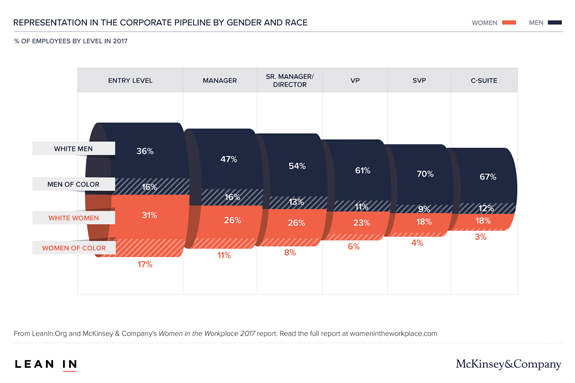The Pipeline Problem: It’s Up To Us To Close the Persistent Gender Gap | Editorial
 I traveled to Indianapolis last month to speak to a group of women leaders about fake news and information literacy. I was invited by Jackie Nytes, the CEO of the Indianapolis Public Library, who is pretty impressive herself. Beyond addressing information literacy with possible change agents, the event presented an opportunity for me to reflect on how far women have come in the journey toward equality in the workplace and how important mentorship and modeling is in that long march.
I traveled to Indianapolis last month to speak to a group of women leaders about fake news and information literacy. I was invited by Jackie Nytes, the CEO of the Indianapolis Public Library, who is pretty impressive herself. Beyond addressing information literacy with possible change agents, the event presented an opportunity for me to reflect on how far women have come in the journey toward equality in the workplace and how important mentorship and modeling is in that long march.
The recent 2017 Women in the Workplace study by McKinsey & Company and Lean In illustrates just how solid the glass ceiling is. Just about 20% of C-suite jobs are held by women, according to data captured from 222 firms. White women bring up the average; for women of color, the situation is worse: they hold only about 3% of C-suite jobs. The study places the problem in the context of a pipeline (see graphic below) and explores some of the reasons it persists, as well as positing some proactive steps organizations can take.
Relevant to librarianship, the promotion gap remains even in female-dominated fields. Though the study focused on corporate America, “we did examine some fields that have a disproportionate share of women. For example, health care and retail,” Irina Starikova, partner, McKinsey & Co., told LJ. “What we find is that despite being overrepresented at the bottom of the pipeline (73% of entry-level positions in health care are filled by women and 60% of those in retail), by the time they reach senior ranks (VP and above)...just about a third of C-suite roles in these fields are filled by women, which is proportionally a similar rate of drop-off relative to the early pipeline numbers as other industries.”
The library field lacks a recent comprehensive look at this, but LJ’s annual Placements and Salaries Survey (“Librarians Everywhere”) indicates that we, too, have a ways to go.

I like that the Lean In study offers practical insight into what drives better outcomes and points to proactive steps managers and organizations can take to foster more women leaders. “We find in our research that retention isn’t the challenge,” said Starikova. “It’s largely a promotion problem.”
What are companies that are closing the gap faster doing? According to Starikova, they “vocalize their commitment across the company and link it to a business case”; they develop managers “that advocate for women and are champions for gender diversity”; they “implement programs specifically designed to improve the promotion rates of women within their organization”; they provide flexible work environments; and they both track and share metrics on gender diversity companywide.
There is much in the report that libraries can use when building programs to support workforce development. The importance of mentoring also resonates throughout the study, bringing me back to the positive impact one person can make. And there is still more impact we can make when our institutions follow through on commitment with action.

RELATED
ALREADY A SUBSCRIBER? LOG IN
We are currently offering this content for free. Sign up now to activate your personal profile, where you can save articles for future viewing









Add Comment :-
Comment Policy:
Comment should not be empty !!!
Candace
When I first graduated from library school, in the mid-1990s, there was only 1 woman among the Canadian research library directors. There are more now, but for a profession that is 85% female, I believe we are still hovering somewhere around half of the cohort of directors of large libraries of all types.Posted : Nov 08, 2017 01:16
librarElady
Until there is mandated paid maternal and paternal leave of at least 8 weeks for every employee in the US, flexible scheduling arrangements (in addition to paid sick and vacation leave, which often aren't really enough for dealing with all of the situations that come up when raising children), and acceptance of bringing children to work with you (particularly in an office type of an environment), or onsite daycare provided as a benefit included with employment, this isn't going to change. This is the case for the library work environment, too. I have been approached about considering a library directorship, but declined, because I'm a woman in the childbearing and child-rearing years of my life, and don't want to be forced to choose between adequately caring for my children and adequately performing my job. The benefits mentioned above aren't usually offered to library staff-- even to potential directors/CEOs.Posted : Nov 07, 2017 01:15